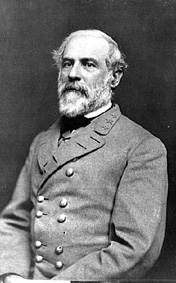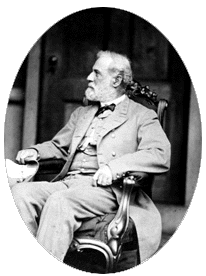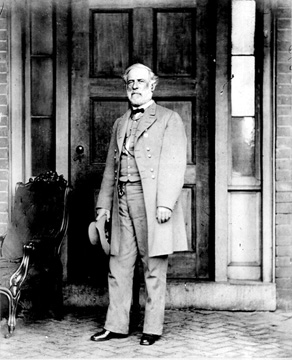

 Robert
E. Lee Robert
E. Lee 
(1807-70)
A brilliant commander of Confederate forces during
the Civil War, he is one of the most famous and respected soldiers
in American history.
After the defeat of the Confederacy, he served as a symbol of
courage in defeat, embodying the finest elements of the Southern
heritage. |
|

|
Robert E. Lee was born on January 19, 1807, in Stratford,
Virginia, the son of Lighthorse Harry Lee,
and was educated at the U.S. Military Academy. He graduated second
in his class in 1829, receiving a commission as second lieutenant
in the engineers. He became first lieutenant in 1836, and captain
in 1838.
He distinguished himself in the battles of the Mexican
War and was wounded in the storming of Chapultepec in 1847; for
his meritorious service he received his third brevet promotion
in rank. He became superintendent of the U.S. Military Academy
and later was appointed colonel of cavalry. He was in command
of the Department of Texas in 1860, and, early the following
year, was summoned to Washington, D.C., when war between the
states seemed imminent.
President Abraham Lincoln
offered him the field command of the Union forces, but Lee declined.
On April 20, three days after Virginia seceded from the Union,
he submitted his resignation from the U.S. Army. On April 23
he became commander in chief of the military and naval forces
of Virginia. For a year he was military adviser to Jefferson
Davis, president of the Confederate
States of America, and was then placed in command of the
army in northern Virginia.
In February 1865 Lee was made commander in chief of
all Confederate armies; two months later the war was virtually
ended by his surrender to General Ulysses S. Grant at Appomattox
Court House. His great battles included those of Antietam, Chancellorsville,
Fredericksburg, and Gettysburg. |

|
The masterly strategy of Lee was overcome only by the superior
resources and troop strength of the Union. His campaigns are
almost universally studied in military schools as models of strategy
and tactics. He had a capacity for anticipating the actions of
his opponents and for comprehending their weaknesses. He made
skillful use of interior lines of communication and kept a convex
front toward the enemy, so that his reinforcements, transfers,
and supplies could reach their destination over short, direct
routes. |
|
|
His greatest contribution to military practice, however,
was his use of field fortifications as aids to maneuvering. He
recognized that a small body of soldiers, protected by entrenchments,
can hold an enemy force of many times their number, while the
main body outflanks the enemy or attacks a smaller force elsewhere.
In his application of this principle Lee was years ahead of his
time; the tactic was not fully understood or generally adopted
until the 20th century. |

|
Lee applied for but was never granted the official postwar
amnesty. He accepted the presidency of Washington College, now
Washington and Lee University, in the fall of 1865; within a
few years it had become an outstanding institution. He died there
on October 12, 1870.
Lee has long been revered as an ideal by southerners and as
a hero by all Americans. His antebellum home is now known as
Arlington House, the Robert E. Lee Memorial, and is a national
memorial. |
|
|
In 1975 Lee's citizenship was restored posthumously
by an act of the U.S. Congress. |
See Bibliography below)
| Back to Timeline
| or click on your browser's "back to previous page"
button
©
Photographs: Library of Congress
Bibliography: Anderson, N. and D., The Generals: Ulysses S.
Grant and Robert E. Lee (1988; repr. 1989); Connelly, Thomas
L., The Marble Man: Robert E. Lee and His Image in American
Society (1977); Davis, Burke, Gray Fox: Robert E. Lee and
the Civil War (1956); Dowdey, Clifford, Death of a Nation
(1988) and, as ed., The Wartime Papers of R. E. Lee (1961;
repr. 1987); Fishwick, Marshall W., Lee After the War (1963;
repr. 1973); Freeman, Douglas S., R. E. Lee: A Biography, 4
vols. (1934-35), and Lee's Lieutenants, 3 vols. (1942-44;
repr. 1986); Fuller, J.F.C., Grant and Lee (1957; repr.
1982); Miers, Earle S., Robert E. Lee (1956); Sanborn,
Margaret, Robert E. Lee, 2 vols. (1966-67); Smith, Gene,
Lee and Grant (1984; repr. 1988).
© Copyright "The American Civil War" - Ronald
W. McGranahan - 2004. All Rights Reserved.
![]()


